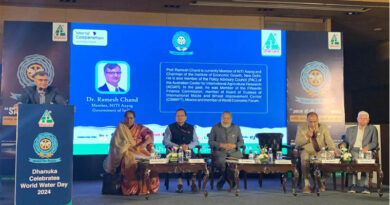Renewables key to achieving climate goals
10 November 2021, New Delhi: Prime Minister Narendra Modi’s ‘Panchamrit’ pledge at the UN-led COP 26 meet in Glasgow, Scotland, includes — Net-zero by 2070, 500 GW fossil fuels by 2030, reducing carbon emissions by 1 billion tonnes, cutting carbon intensity by 45 per cent and climate finance. These go beyond earlier pledges at UN Framework Convention on Climate Change (UNFCCC), Kyoto Protocol and Paris Agreement.
In fact these pledges go beyond India’s National Action Plan on Climate Change (NAPCC). These steps are welcome but can the country achieve them?
India’s primary energy consumption will grow 156 per cent by 2040 (BP Energy Outlook, 2019). India will also account for 25 per cent of the rise in global energy use by 2040. Though India’s per capita primary energy consumption is still only a third of the global average, it is going through its most energy intensive phase, which is expected to continue for next couple of decades.
Also, by 2040, 42 per cent of India’s new demand is to be met by coal leading to more CO2 emissions. India is equally vulnerable to climate change as its agriculture is monsoon-dependent and nearly 175 million people living along India’s 7,500 km coastline confronting rising sea level.
Despite the recent strides in renewable energy, India still largely depends upon coal (around 55%) and oil (30%) for energy sources. The share of hydroelectricity in India’s energy mix has been slowing. But the share of solar and wind has accelerated over last two decades.
According to IBEF, 2017, India’s potential in RE sources such as solar, wind, hydro power, biomass small hydropower are 750 GW, 102 GW, 145 GW, 25 GW respectively. India’s total installed capacity from all sources today is 388 GW.
A solar power plant offers good option for electrification in hilly regions, forests, deserts and islands where other resources are neither available nor viable. To meet 40 per cent of India’s power needs from RE by 2030, we need to utilise the existing potential.
Government initiatives
The government has been promoting renewables since Electricity Act 2003. Subsequently National Electricity Policy, 2005; National Clean Energy Fund, 2010; revised tariff policy 2016, were formulated to incentivise and create a market for renewable energy sector.
Further, the launch of Jawaharlal Nehru National Solar Mission (JNNSM) in 2008 gave thrust to solar energy by giving capital subsidy. So far, about 40 GW of solar electric generation capacity has been installed. The government also tried to create the market for renewable energy suppliers with policies like Renewable Purchase Obligation (RPO), which directs Discoms to purchase power from renewable energy sources and Renewable Energy Certification (REC) compliance of RPO.
Some of the policies under National Action Plan of Climate Change such as the Energy Conservation Building Code (ECBC) to save energy and Unnat Jyoti by Affordable LEDs (UJALA) to save energy and reduce emission are welcome.
Further, the National Bio-fuels Policy 2018 targets 20 per cent blending of ethanol in petrol and 5 per cent blending of biodiesel in diesel by 2030. Recent initiatives include reducing GST on electric vehicles from 12 per cent to 5 per cent, sustainable solid waste management; reduced customs duty for nuclear power plants etc.
The budgetary allocation for RE sector has been increasing every year with ₹5,753 crore allocated in Budget 2021-22.
FDI inflows into non-conventional energy between 2000 and 2020 was $9.83 billion. In total, $42 billion has been invested in India’s RE sector since 2014 and India ranks third in the world in terms of investments in 2020. Despite these investments, potential barriers (infrastructure, finance) in tapping RE still exist.
More subsidies for adopting green technology and EVs are needed. Effective implementation of RECs and RPOs (the two complement each other) is key to driving renewable energy.
The PM’s call to developed nations to cough up $1 trillion to the developing world to fight climate change is justified. One of the tools used for climate financing is Green Bonds. Alternative debt vehicles such as “Green” asset backed securities could be a potential financial instrument for RE.
“Green” investment banks, government-funded entities, can “crowd in” private investment in low-carbon assets. The government can issue bonds through private or public banks, World Bank and regional development banks to tap both domestic and international investors.
Domestic institutional investors mainly invest in less risky securities and other financial assets. There is limited understanding of RE sector and investors are reluctant. Domestic investors opt more for liquid assets with good credit rating which is not available in RE projects.
Another barrier for Indian institutional investors is a shortage of financial intermediaries who can provide proper information about investment opportunities in the RE sector. Renovating old coal-burning facilities and incorporating ultra-low emissions technology, by giving further thrust to solar, wind, hydropower are viable options.
The developed countries and multilateral organisations should share responsibility and help India achieve its pledges within the timeframe.
The writer is Professor, Institute of Economic Growth, Delhi















